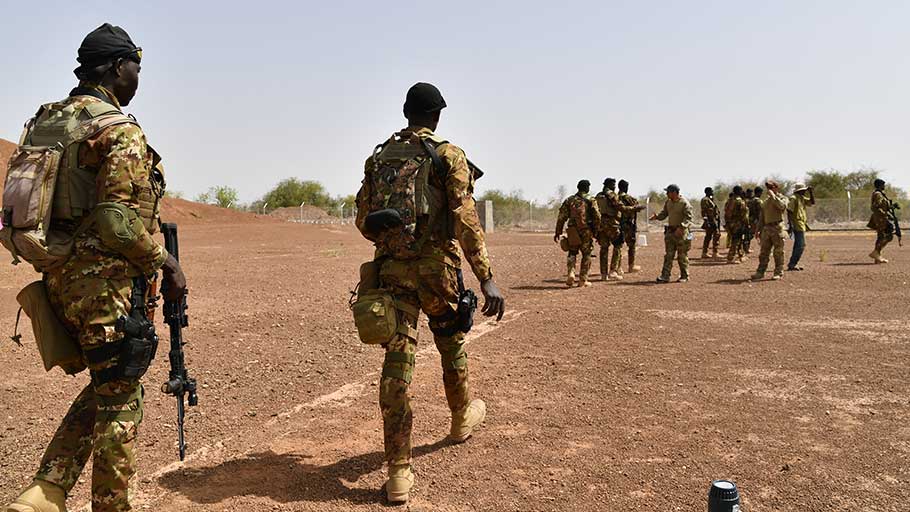The deadly ambush in Niger last October that left four U.S. serviceman dead prompted months of hand-wringing inside the Pentagon. But that botched operation, which drew national attention to U.S. counterterror operations throughout Africa should not have shocked military leadership, the former commander of U.S. Special Operations forces in Africa told VICE News.
“These weren’t the first casualties, either. We had them in Somalia and Kenya,” said retired Brig. Gen. Donald Bolduc, who served as commander of Special Operations Command Africa (SOCAFRICA) from April 2015 to June 2017, in an interview with VICE News. “We had them in Tunisia. We had them in Mali. We had them in Niger, Nigeria, Cameroon, and Chad. But those were kept as quiet as possible. Nobody talked about it.”
Indeed, two separate military efforts — named Juniper Shield and Obsidian Nomad — that were set to intersect but failed to on the night of the deadly ambush near Tongo Tongo in Niger were part of a pattern of expansion on the African continent that has made it the most active U.S. military theatre in the world. The United States has conducted more than 30 named operations and activities in Africa over the last three years, according to documents obtained by VICE News. While more troops are deployed to, and engaged in combat in, the Greater Middle East, the sheer number of named efforts in Africa actually surpasses that region.
“What we’re doing shouldn’t be a mystery.”
VICE News reviewed documents from the U.S. Army, Africa Command, and Special Operations Command Africa, and conducted interviews with current and former military personnel and experts familiar with America’s “war on terror” in Africa. These documents and testimony paint a startling picture of a sprawling, labyrinthine, and at times chaotic shadow war on the African continent, in which commandos are endangered by a lack of resources and “assistance” operations blur with combat.
“Africa has more named operations than any other theater, including CENTCOM [the command that oversees the Middle East],” Buldoc confirmed to VICE News. “But remains under-resourced for doing what it’s been directed to do.”
Secretive and Sprawling
In 2017, U.S. troops carried out an average of nearly 10 missions per day —3,500 exercises, programs, and engagements for the year — across the African continent, according to Gen. Thomas Waldhauser, the AFRICOM commander.
These efforts — carried out in at least 33 countries — range from capture-or-kill commando raids to more banal training missions. Americans are also gathering intelligence, involved in surveillance and reconnaissance missions carried out by drones, engaged in construction projects, and accompanying allies on tactical operations.
There are also now 34 U.S. military outposts on the continent, concentrated in the north and west and the Horn of Africa, according to a recent report by The Intercept.
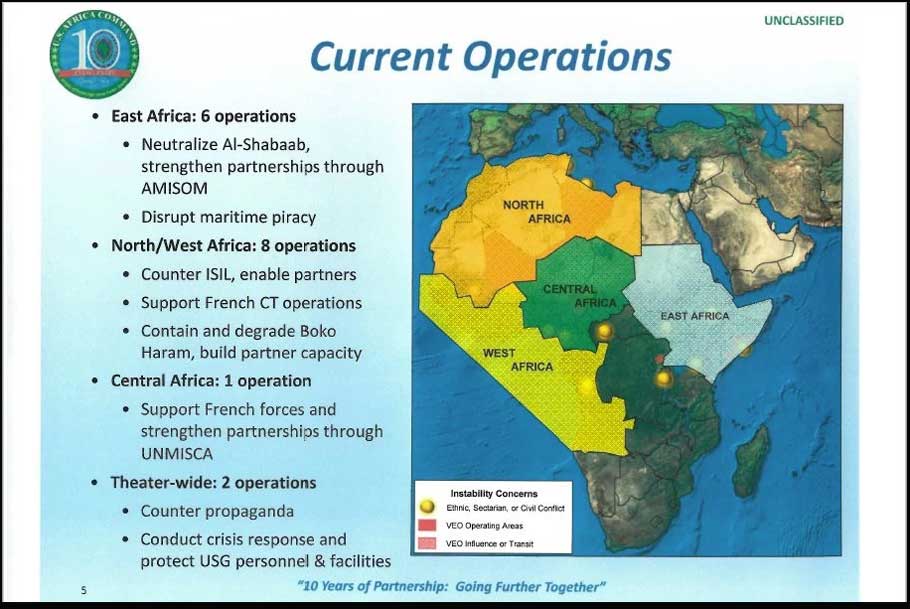
This March 2018 briefing authored by Africa Command Science Advisor Peter Teil outlines current U.S. military operations throughout the African continent. (Nick Turse for VICE News).
Through the Freedom of Information Act (FOIA), AFRICOM provided VICE News with a list of 21 named operations conducted between January 1, 2016 and September 25, 2018. According to a separate March 2018 briefing, authored by Africa Command Science Advisor Peter Teil and also obtained via FOIA, eight current operations in North and West Africa were aimed at countering the Islamic State and Boko Haram and assisting local allies and French counterterrorism efforts. Six operations in East Africa focused on defeating al Shabaab, assisting the African Union Mission in Somalia, and counter-piracy. Two theater-wide efforts focused on crisis response in the event U.S. government personnel or facilities are threatened, while one operation — Echo Casemate — provides support to French and U.N. forces in the troubled Central African Republic.
A separate Defense Department document, marked “For Official Use Only,” that appears to have been posted online inadvertently, lists 12 named activities not on AFRICOM’s list, including eight in the east and another four in the northwest.
Taken together, these documents represent the most current and complete record of named U.S. operations and activities recently conducted on the continent, offering a window into a collection of little-understood, often overlapping, military efforts unknown to most Americans.
Spread Thin, and Blurring Lines
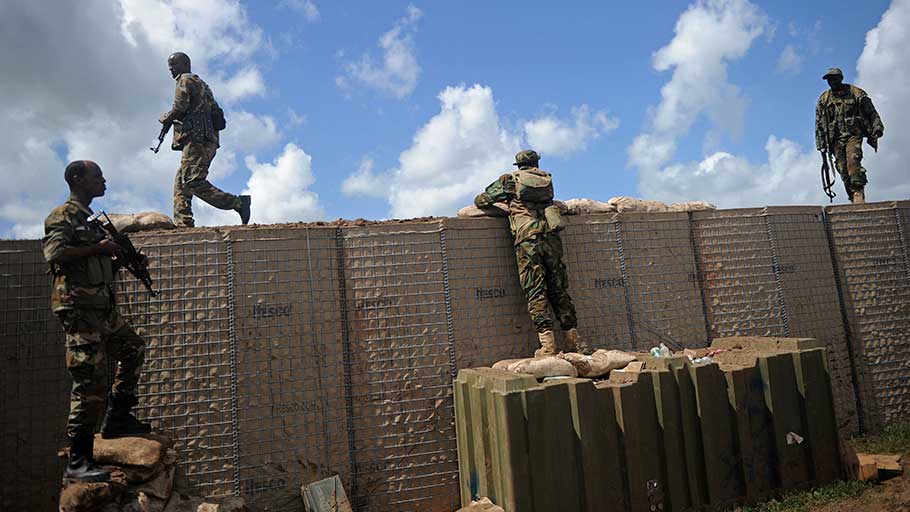
Somali soldiers are on patrol at Sanguuni military base, where an American special operations soldier was killed by a mortar attack on June 8, about 450 km south of Mogadishu, Somalia, on June 13, 2018. – More than 500 American forces are partnering with African Union Mission to Somalia (AMISOM) and Somali national security forces in counterterrorism operations, and have conducted frequent raids and drone strikes on Al-Shabaab training camps throughout Somalia. (MOHAMED ABDIWAHAB/AFP/Getty Images).
The proliferation of so many concurrent counterterrorism efforts courts danger, said Bill Hartung, the director of the Arms and Security Project at the Center for International Policy.
“Running so many operations with combat implications without making them known to the American public is both unwise and ultimately undemocratic. It is no way to run foreign policy in a democracy,” he said. “And running sensitive operations that are secret, or simply not widely publicized, increases the risks of failure, because they are not subject to public debate or adequate scrutiny.”
Bolduc also criticized the lack of transparency on the part of AFRICOM. “What we’re doing shouldn’t be a mystery,” he said.
Alice Hunt Friend, the principal director for African affairs in the Office of the Under Secretary of Defense for Policy from 2012 to 2014, said the risks are compounded by the way these operations tend to blur between “assistance” and combat.
“Running dozens of missions where U.S. troops are liable to be thrust into combat roles is an extremely risky approach, putting both their lives and our interests at risk.”
“If the primary military activity in a country is assistance, then as we saw in Niger, U.S. combat-related resources are not readily on hand,” Friend explained.
Among the operations that provide “assistance” are the classified 127e programs. These secretive efforts are “aimed at assisting foreign forces who support U.S. counterterrorism operations,” said Friend.
But these activities often consist of far more than assistance, said Bolduc. Classified 127e programs are “direct action” efforts, which are defined by the Pentagon as “short-duration strikes and other small-scale offensive actions conducted as a special operation in hostile, denied, or diplomatically sensitive environments.”
Such direct-action missions were carried out in Cameroon, Kenya, Libya, Mali, Niger, Somalia, and Tunisia in recent years, as well as two nations where the 127e programs have now ended, Ethiopia and Mauritania, said Bolduc.
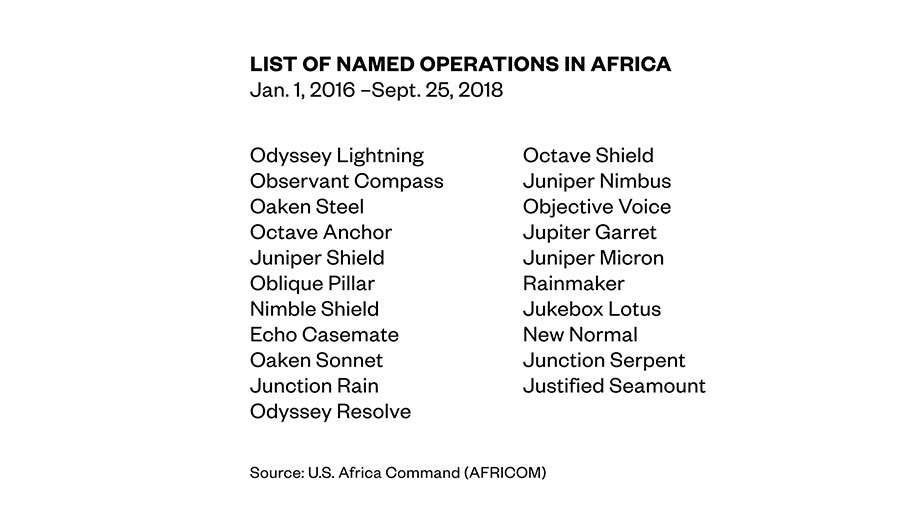
Through the Freedom of Information Act (FOIA), AFRICOM provided VICE News with a list of 21 named operations conducted between January 1, 2016 and September 25, 2018. Above is the list. (Nick Turse for VICE News.)
The Department of Defense declined to provide details about these activities because many were “ongoing,” said Navy Commander Candice Tresch, a Pentagon spokesperson.
“We are extremely lucky that there have not been more situations like Niger,” said Hartung. “Running dozens of missions where U.S. troops are liable to be thrust into combat roles is an extremely risky approach, putting both their lives and our interests at risk.”
Buldoc expressed particular concern over what he explained was a persistent lack of support from the Pentagon. “When I left command, I had 96 missions and 886 tasks associated with those missions in 28 different countries, in an area that was two and a half times the size of the United States,” Bolduc said. “I was under-resourced in personnel recovery. I was under-resourced in ISR [intelligence, surveillance, and reconnaissance assets]. And I was under resourced in medical support — the three key things that I needed.”
For years, the special operations community and its supporters have expressed concern over deployment rates, operations tempo, and the amount of resources being allocated to direct action missions. “Most SOF units are employed to their sustainable limit,” General Raymond Thomas, the Special Operations Command chief, told members of Congress last spring.
In June, the New York Times reported that Secretary of Defense James Mattis and Gen. Joseph F. Dunford Jr., the chairman of the Joint Chiefs of Staff, had grown concerned that commandos across the globe were spread too thin. And the resources afforded to the team ambushed in Niger in 2017, for example — who relied on contracted medical evacuation services, French airpower, and lightly armored vehicles — have been criticized as inadequate and dangerous.
Bolduc, the former SOCAFRICA commander, laid much of the blame of the Niger ambush on such deficits and a failure to adequately support local allies. “That lack of resources — as well as fundamentally misunderstanding the environment, the situation, and the threat — meant that we were unable to help our partners solve a regional problem. Because we didn’t provide an adequate military and security response, the threat got stronger and more effective. The direct result was the ambush of our SOF team in October 2017.”
Africa Command’s official investigation, however, concluded that the “direct cause of the enemy attack in Tongo Tongo is that the enemy achieved tactical surprise there, and our forces were outnumbered approximately three to one,” according to AFRICOM’s former chief of staff, and now the head of the U.S. Army in Africa, Maj. Gen. Roger Cloutier.
Drawing Down — Sort of
The Pentagon told VICE News that the total number of troops assigned to AFRICOM — about 7,200 personnel — would be cut by less than 10 percent over several years, as it reviews its priority areas on the continent and reorients itself toward great power rivals.
There are, by comparison, roughly 24,000 troops deployed to Afghanistan, Iraq, and Syria, although President Trump recently suggested that U.S. troops might be withdrawn from the Middle East due to lower oil prices.
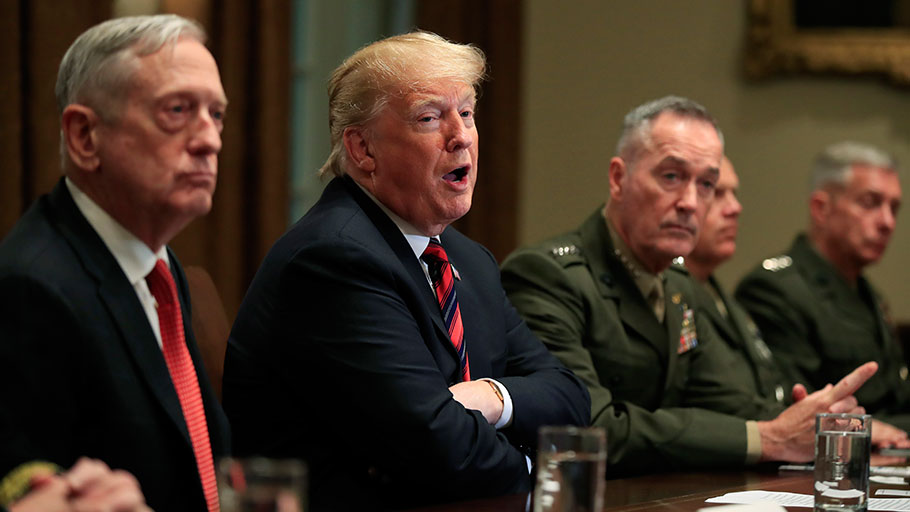
President Donald Trump with, from left, Defense Secretary Jim Mattis, Trump, Chairman of the Joint Chiefs of Staff Gen. Joseph Dunford and Marine Corps Commandant Gen. Robert Neller, speaks during a briefing with senior military leaders in the Cabinet Room at the White House in Washington, Tuesday, Oct. 23, 2018. (AP Photo/Manuel Balce Ceneta)
Pentagon spokesperson Tresch said that the ambush in Niger had nothing to do with the Defense Department’s decision to modestly decrease troop levels in Africa. She said the move is predicated on the National Defense Strategy, released earlier this year, which calls for increased focus on near-peer competitors. The Trump administration is reportedly poised to unveil a broader strategy for Africa specifically focused on countering the influence of Russia and China on the continent.
“We’re basically ceding our strategic leverage and relationship with our African partners to the Chinese and the Russians.”
“As we prioritize where we need to place concentrations of troops, there were certain specialties — especially in the Special Operations arena — that we didn’t necessarily need employed in Africa,” AFRICOM’s Senior Enlisted Leader Chief Master Sergeant Ramon Colon-Lopez told VICE News.
Few, if any, troops will be cut from hotspots like Libya and Somalia, nor Djibouti, whose bases also play a pivotal role in U.S. operations in Yemen and the greater Middle East. Nor will any region of the continent see all U.S. forces removed. Troop drawdowns in West Africa will be marked by a shift from tactical-level support to a greater emphasis on advising, training and intelligence-sharing, the Pentagon said.
Bolduc, who supports robust military and diplomatic engagement on the continent, warned that any significant cuts to special operations forces would irreparably harm U.S. interests in Africa. “We’re becoming risk averse and it’s slowing down the amount of support we provide to our partner nations in training, advising, assisting, and accompanying them,” he said. “We’re basically ceding our strategic leverage and relationship with our African partners to the Chinese and the Russians.”
But Friend said there was greater risk in small teams of special operators conducting far flung and secretive missions on the continent.
“The fact that American forces were out in the field like that made them vulnerable to [ISIS in the Greater Sahara] attacks. If they’re not forward and not out there, it’s much harder to attack them,” she said. “So, one of the choices in front of DoD decision-makers is ‘do we want to keep forces forward?’ and therefore ‘what kind of support do we need to give them?,’” Friend said.
Cover image: Malian soldiers take part in training at the Kamboinsé general Bila Zagre military camp near Ouagadougo in Burkina Faso during a military anti-terrorism exercise with US Army instructors on April 12, 2018. (ISSOUF SANOGO/AFP/Getty Images)

